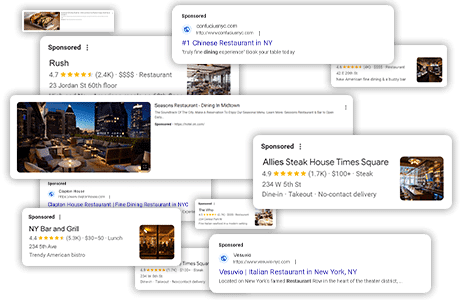A Beginner’s Guide to Google Ads for Restaurant Marketing

Why Google Ads Matter for Restaurants
Google Ads has become a vital tool for restaurants seeking to attract more customers. It’s designed to boost foot traffic, increase reservations, and promote delivery orders. In an era where convenience is king, Google Ads allows eateries to reach potential patrons exactly when they’re deciding where to eat.
With the digital landscape constantly evolving, the reliance on online searches for restaurant recommendations has surged. Restaurants are now recognizing the necessity of having a robust online presence. Digital advertising isn’t just a buzzword; it’s essential for staying competitive and topping search results when hungry customers are on the hunt.
Why choose Google Ads, specifically? The platform is unmatched in its ability to target local diners who are actively searching for their next meal. Whether it’s a family looking for Italian cuisine or a couple searching for a romantic dinner spot, Google Ads puts restaurants directly in the line of sight of their ideal audience.
A Word of Warning:
While Google ads can be very powerful, note that it’s definitely not the easiest thing to make work. If you’re busy with your restaurant and you find the learning curve a bit too steep you may want to consider hiring a restaurant marketing and consulting service like Rezzonator to manage your marketing and make sure you get results. This way you can focus on running your restaurant. You can go here for more details.

Need More Clients?
Marketing that Gets Results
GUARANTEED
Try it FREE *
* must qualify for offer
Table of contents:
- Why Google Ads Matter for Restaurants
- Setting Up Your First Google Ads Campaign for Your Restaurant
- Choosing the Right Keywords: How to Target Hungry Diners
- Creating Compelling Ad Copy that Converts
- Targeting Local Audiences with Geo-Targeting and Local Search Ads
- Budgeting for Success: Maximizing ROI on Google Ads
- Using Google Ads Retargeting to Bring Back Lost Diners
- Tracking and Measuring the Success of Your Google Ads Campaigns
- Advanced Tips and Tricks for Google Ads Success in 2025 and Beyond
- Growing Your Restaurant with Google Ads
Setting Up Your First Google Ads Campaign for Your Restaurant
Starting your first Google Ads campaign involves a few essential steps. Before you do anything you’ll need to open an Google ads account. Once you do that you can create a new campaign.
[create campaign]

Choose a campaign goal that aligns with your restaurant’s aim, be it getting more calls, driving visits to your location, or enticing people to your website. Next, define your budget. You can opt for a daily spending limit to keep costs in check, ensuring your advertising efforts align with your fiscal plans.
Selecting Your Campaign Type
Google offers several advertising campaign types: Search, Display, and Local campaigns. Search Ads appear next to Google search results when people look for restaurants like yours. Display Ads can show up on websites across the internet, while Local Ads help to drive foot traffic to your restaurant. It’s crucial to pick the one that aligns with your targets.
As you get more advanced you’ll probably go with “Create a campaign without a goal’s guidance”. That’s because the default Google ads campaign types tend to be a bit inneficient leading to a loss of money and very little results unless they’re heavily tweaked. We’ll talk more about this later.
[choose campaign type]
Choosing the Right Campaign for Your Goals
Let’s determine the best campaign for your needs. For promoting takeout or delivery services, Search campaigns can be highly effective, allowing you to appear in front of hungry customers with intent to buy. If you’re focusing on reservations, consider Local campaigns that encourage nearby patrons to dine in. On the other hand, if you’re aiming to increase brand recognition, Display campaigns can showcase your restaurant’s vibe through visual ads scattered across the web. Each type serves a unique purpose, so choose based on your specific goals for the best results.
- Search Campaigns: Ideal for immediate actions like takeout or delivery orders.
- Display Campaigns: Great for visual storytelling and brand awareness.
- Local Campaigns: Best for driving foot traffic to your brick-and-mortar location.
Your best bet, unless you’re experienced, is probably the Local Campaigns, though you’ll have to watch out for major problems. We’ll detail those later.
Choosing the Right Keywords: How to Target Hungry Diners
Finding the ideal keywords is critical for connecting with potential customers who are searching for exactly what your restaurant offers. Start with Google’s Keyword Planner for research. Here, input terms related to your menu, like ‘pasta’ or ‘tacos’, and discover variations such as ‘best pasta near me’ or ‘tacos delivery’. High-intent keywords like these signal a ready-to-dine customer and can drive meaningful traffic to your site.
[discover new keywords 1]
[discover new keywords 2]
Think specificity when it comes to long-tail keywords. Select phrases that match your restaurant’s offerings, such as ‘vegan friendly Mediterranean restaurant’ or ‘New York style pizza takeout’. Incorporating elements like your type of cuisine, location, and services streamline efforts to capture the search queries most relevant to what diners are seeking. Long-tail keywords often result in higher conversion rates, as they catch customers further down the purchase funnel.
Balancing your keyword approach is vital. Combine broad match keywords—general terms related to your business like ‘restaurant’ or ‘dinner’—with exact match keywords—specific phrases like ‘make a reservation Italian restaurant’. This strategy lets you cast a wider net while also zoning in tightly on those crucial searches that indicate immediate interest or need. It’s a way to manage ad spend efficiently, ensuring dollars are spent on ads that are more likely to convert, and not wasted on irrelevant clicks.
Creating Compelling Ad Copy that Converts
Mastering the art of ad copy is crucial for turning searches into sales. Begin by crafting headlines that resonate with what potential customers are seeking. For instance, a headline like ‘Order from NYC’s Best Italian Restaurant’ directly matches the searcher’s intent, whether they’re craving pasta or looking for top-rated dining experiences. It’s specific, it conveys quality, and it connects with the geographic location they are interested in.
[create ad copy]
Enhance your Google Ads with useful ad extensions. Sitelinks can guide customers to specific pages like your menu or reservations, while call extensions add a phone number right to the ad, making it easier for customers to reach you. Don’t forget location extensions; they provide a map pinpointing your restaurant. These extensions not only make your ad larger and more visible, but they also offer valuable information at a glance, increasing the likelihood of a click-through.
Finally, calls-to-action (CTAs) are your ads’ sign-off, prompting immediate responses. Phrases like ‘Order Now’ create urgency, while ‘Book a Table’ offers a clear next step. CTAs should be action-oriented and encouraging, nudging the audience towards making a decision that benefits both them and your restaurant. The right CTA can significantly boost your ad’s performance by giving potential customers a clear understanding of how to proceed.
Targeting Local Audiences with Geo-Targeting and Local Search Ads
To maximize advertising efficiency for your restaurant, setting up geo-targeting is crucial. It means that your Google Ads will appear only to potential customers located within the defined region of your restaurant’s service area, which could include delivery zones or dining vicinities. Establishing geo-targeting involves selecting the specific geographic locations you want your ads to be displayed during the campaign setup process. This ensures you are not spending advertising dollars on users who can’t physically patronize your restaurant.
Local Search Ads are an additional tool to enhance your restaurant’s visibility, specifically targeting people who are actively searching for dining options on Google Maps. When your ad is set up as a Local Search Ad, it can appear at the top of search results in Maps, making it one of the first options seen by those hunting for food in the area. This feature is uniquely beneficial for attracting foot traffic from individuals who have an immediate desire to eat and are nearby.
To further optimize your ads, incorporate phrases like ‘near me’ or ‘close by’ in your ad copy. Many users search for restaurants using these terms, especially on mobile devices when they’re looking for a meal on the go. By including such phrases, you increase the likelihood of your ad showing up in these real-time, location-specific searches. This strategy is an effective way to capture the attention of diners when they are at the decision-making stage and are likely to act on the ads they see.
- Set your ad’s geographic boundaries to align with your restaurant’s service area for efficient targeting.
- Use Local Search Ads to feature prominently on Google Maps and increase the chance of immediate visits.
- Optimize your ad’s visibility in searches with local intent by using common phrases like ‘near me’.
Budgeting for Success: Maximizing ROI on Google Ads
When diving into Google Ads for your restaurant, starting with a realistic budget is key. It’s as simple as aligning your spending with your goals. Think smaller, such as $10 a day, for creating buzz locally. If you’re focusing on boosting delivery orders, a higher budget, like $50 daily, may be needed. The goal is not to pour money into ads haphazardly but to strategically plan where each dollar goes.
Bidding strategies can make or break your Google Ads performance. ‘Maximize Clicks’ is the go-to for getting as many people as possible to click on your ads within your budget. On the other hand, ‘Target CPA’ (cost per acquisition) is a savvier approach if you’re tracking conversions closely; it focuses on getting customers at a cost that makes sense for your bottom line. It might sound technical, but these strategies are built to stretch your ad dollars further.
Keep a watchful eye on your cost-per-click (CPC) and how often those clicks turn into tangible actions, like orders or bookings. Are clicks costing more than expected? Are customers taking the action you want? By monitoring these metrics, you can tweak your ads, adjust your budget, and refine your bids to get a better return on your investment (ROI). Making these informed adjustments ensures you get the most bang for your buck. So, you’re not just spending; you’re investing wisely.

Using Google Ads Retargeting to Bring Back Lost Diners
Retargeting campaigns harness the power of reminder marketing by displaying your ads to individuals who’ve engaged with your website but left without booking a table or ordering food. This strategy keeps your restaurant top-of-mind, coaxing them back to complete the dining experience they initially considered.
Implementing retargeting ads is straightforward. To specifically target past visitors, use Google Ads to set up campaigns promoting exclusive offers or time-sensitive deals that incentivize a return visit. This could be a discount on their next meal or a tantalizing picture of a weekly special that’s hard to resist. The key is to act as a personalized nudge to remind them of what they’re missing out on and make completing their order a no-brainer.
- Use past behavior to tailor ads – The dishes a user viewed or the time they spent on your menu page can inform personalized ads.
- Employ urgency in your messaging – Highlight limited-time offers to create a sense of scarcity and prompt immediate action.
- Optimize for conversion – Ensure that the path from the ad back to your site is as seamless as possible to maximize the chances of converting the click into a reservation or order.
Tracking and Measuring the Success of Your Google Ads Campaigns
To assess the effectiveness of your Google Ads, integrate Google Analytics with your Google Ads account. This setup will allow you to track important metrics such as the number of clicks your ads receive, the frequency your ads are shown (impressions), and the actions taken by users (conversions).
Focus on key performance indicators (KPIs) that will give you insight into your campaign’s efficiency. Key KPIs include the click-through rate (CTR), which is the percentage of people who click on your ad after seeing it; conversion rate, the percentage of clicks that result in a desired action like a reservation; and return on ad spend (ROAS), which measures the revenue earned for every dollar spent on advertising.
Utilize A/B testing to refine your Google Ads strategy. By creating two versions of your ads or landing pages, you can compare performance metrics to determine which elements resonate best with your audience. Employ this method to continually optimize your ads, refine your landing pages, and enhance keyword targeting, which can help improve campaign performance over time.
Advanced Tips and Tricks for Google Ads Success in 2025 and Beyond
Leveraging Smart Campaigns and Machine Learning
To get ahead in the competitive restaurant industry, embracing automation through Google Ads Smart Campaigns can be a game-changer. These campaigns use machine learning to fine-tune your ads for you, aiming to bring in more traffic to your restaurant’s website or even direct phone calls to your reservations team. Importantly, they analyze historical data and ongoing campaign performance to optimize your spending and targeting. This means you can focus more on your restaurant and less on micromanaging your ads!
Ad Scheduling During Peak Hours
Timing is crucial in the restaurant business, and the same goes for your online ads. Set up ad scheduling in Google Ads to ensure your promotions are seen during your restaurant’s busiest times, like lunch and dinner. By doing this, your ads will reach potential customers just as they’re starting to think about their next meal. You won’t waste budget on off-hours when the appetite for your offerings is low, plus you’ll catch those last-minute diners right when they’re ready to make a decision.
Location-Specific Landing Pages for Higher Relevancy
A location-specific landing page is a must-have when people click through your ads. These pages should seamlessly match the messaging and offer in your ad, but they also need to be tailored to the respective locale. If your restaurant chain operates in multiple cities, create a unique landing page for each area, highlighting local specials, events, or even popular menu items. This connection assures customers they’ve come to the right place and can lead to significantly better conversion rates as your pages resonate with the local community and their specific dining interests.
Growing Your Restaurant with Google Ads
By now, you’ve seen the powerful impact Google Ads can have on both your restaurant’s online visibility and foot traffic. It’s clear that strategically crafted ads can lead to increased bookings, more takeaway orders, and a broader customer base.
Let’s not forget that the digital advertising landscape is always evolving. To stay ahead, you need to keep a keen eye on the latest Google Ads trends. Make it a routine to tweak and refine your campaigns. This continuous optimization is key to getting better results over time.
Lastly, don’t shy away from innovation. Try out new features and advertising approaches. Every restaurant is unique, and there’s no one-size-fits-all strategy. It’s through experimenting and analyzing the outcomes that you’ll discover the winning formula tailored for your venue. So go ahead, harness the power of Google Ads, and watch your restaurant thrive in 2025 and beyond.
Need More Clients?
Marketing that Gets Results
GUARANTEED
Try it FREE *
* must qualify for offer
